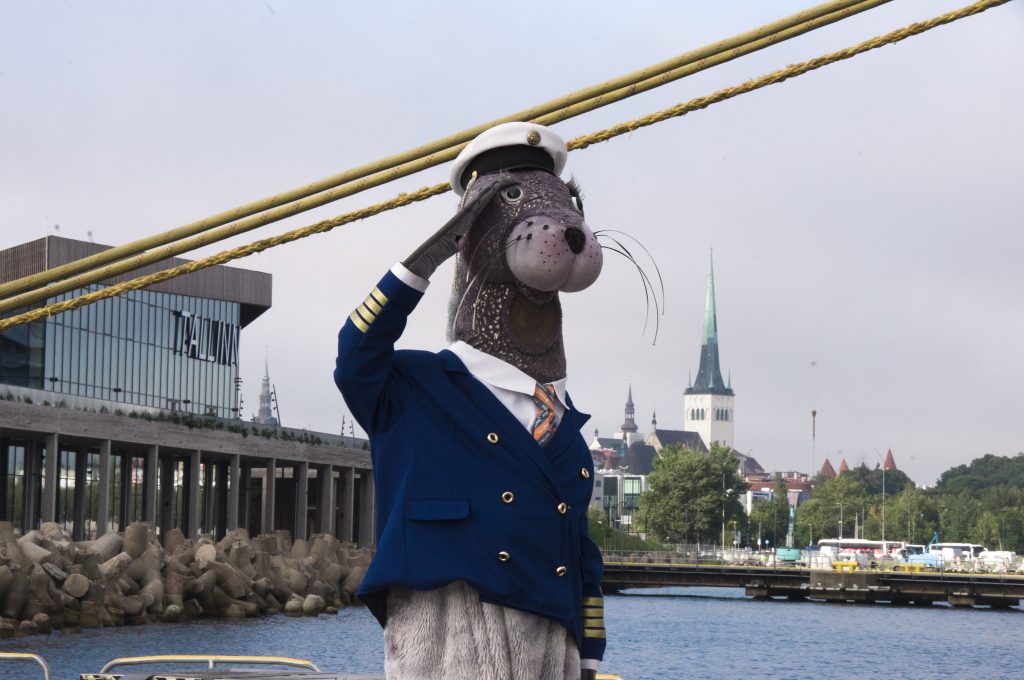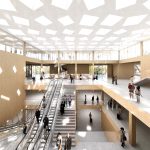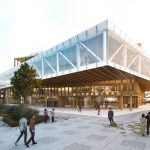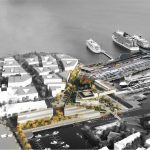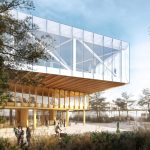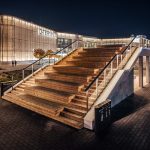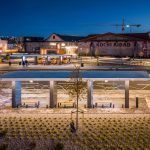LEED (Leadership in Energy and Environmental Design) is the world’s most widely used green building certification system. This certification acknowledges buildings designed, constructed and operated in accordance with the principles of environmental sustainability and sustainable development. It provides independent, third-party validation from the U.S. Green Building Council (USGBC) that a building is designed, built and managed with commitment to protecting human health and the environment.
In addition to certifying individual buildings, LEED places significant importance on ensuring that the surrounding spaces—the entire neighborhood—are developed in a manner that promotes environmental and human health. The development of Vanasadam focuses not only on meeting certification requirements but also on enhancing the well-being and experience of its users. The planning process emphasizes daily convenience, recreational opportunities, and the creation of a healthy and accessible urban environment.
AS Tallinna Sadam prioritizes high quality and environmental sustainability in its plans for the Vanasadam real estate development. The goal of LEED certification is to encourage market behavior that supports sustainability and eco-friendly practices. The preliminary study confirmed that the planning solutions and designs for the new urban space are aligned with these principles, and achieving LEED GOLD certification for the Vanasadam neighborhood is within reach. Neighborhoods and development areas are key drivers of change and innovation. By strategically developing neighborhoods, there is tremendous potential to create a greener and more livable environment that addresses the impacts of climate change while minimizing the ecological footprint through sustainable practices. The LEED certification framework emphasizes the importance of a development’s location and its accessibility via public transportation, as well as its walkability and cycling infrastructure. It also highlights the integration of green spaces, on-site stormwater management, diverse building types, and energy-efficient structures. Steps taken under the LEED certification process will help the Vanasadam area reduce its carbon footprint and create a more climate-resilient urban environment. Key initiatives include adopting energy-efficient technologies, implementing nature-based stormwater solutions, and promoting sustainable transportation. These efforts align with the long-term vision of AS Tallinna Sadam as an environmentally responsible and forward-thinking developer.
The preliminary study for LEED certification for neighborhood development in the Vanasadam area was conducted by Forus Haldus OÜ. Alongside Finnish engineering companies operating in the Estonian market, Forus has completed the highest number of certification processes. Operating across the Baltic region, our advantage is the ability to offer comprehensive solutions for LEED certification, including energy simulations and building Life Cycle Assessments (LCA). Forus is dedicated to ensuring that developments are not just “green” on paper but contribute meaningfully to creating sustainable and human-centric urban spaces.
The Vanasadam (Old City Harbour) tramway was officially opened today, with regular tram services set to begin on Sunday, December 1.
The tramline was constructed by Merko Ehitus Eesti and KMG Infra. The project, which began in the spring of 2023 and concluded in the fall of 2024, involved the construction of approximately 2.5 kilometers of double-track tramline, complete with stops and a substation. Significant upgrades were also made to underground utilities and the surrounding streetscape.
The new tramline branches off from the Tartu maantee tramline, with a switch installed onto Gonsiori Street. The route then proceeds via A. Laikmaa, Hobujaama, and Ahtri Streets to the harbour area, continuing through the Cultural Hub and Linnahall to connect with the tramline leading to Kopli.
Starting December 1, tramline 2 will operate on the new tracks, running initially on the route Kopli–Vanasadam–Suur-Paala. Once construction of the Rail Baltica Ülemiste terminal progresses to allow trams to pass through the area, the line will be extended to the airport as soon as possible.
The new timetable for line 2 can be found on the website transport.tallinn.ee and will also be displayed at tram stops along the route starting Sunday. More details about the tramline and recent changes can be found at www.tallinn.ee/en/vanasadamatramm.
29.08-01.09 leiab aset Tallinna linnaruumifestival, mille eesmärk on kutsuda kõiki linlasi kliima, elukeskkonna ja linnaruumiteemadel kaasa mõtlema ja tegutsema. Tänavuse linnaruumifestivali fookuses on mereäär. Seetõttu viiakse festival läbi ka mere ääres.
Kutsume Sind osalema reedel, 30. augustil kell 12.00-16.00 toimuvale arutelupäevale koos Tallinna Sadamaga. Päeva fookuses on Vanasadama kinnisvaraarendus ja sellega haakuvad aktuaalsed teemad. Arutelud toimuvad festivali pealaval Linnahalli taga, merepoolses küljes. Arutelusid juhib Urmas Vaino.
Arutelud:
12:00 Avanev Mereäär: Sadama ja linnaruumi koosloome
Arutlejad: Madle Lippus (abilinnapea), Valdo Kalm (Tallinna Sadam), Kadi Pärnits (Ülemiste City) ja Marko Uueda (Capital Mill)
13:00 Tallinn liikuvamaks ja mere äärde tulek lihtsamaks
Arutlejad: Pärtel-Peeter Pere (abilinnapea), Raul Kalvo (Liikuvusagentuur), Kaido Padar (TLT), Piret Üts (Tallinna Sadam)
14:00 Roheline Tulevik: Energeetika linnakeskkonnas
Arutlejad: Robert Kitt (Utilitas), Ivo Palu (TalTech), Taavi Tilk (Tallinna Sadam)
15:00 Tärkav Sadama Asum – argipäeva rõõmud ja mured
Arutlejad: Sander Andla (Kesklinna vanem), Ann Tarkin (Sadama asumi elanik), kohalik ettevõtja Sadama asumist
– 30. ja 31.08 toimuvad ka giidituurid „Avatud sadam“, huvi korral registreeru siin: www.tallinn.ee/et/linnaruumifestival/registreerumine
– Tutvu kogu festivali programmiga siin: www.tallinn.ee/et/linnaruumifestival/programm
Osalemine on tasuta ning osalejate arv ei ole piiratud. Riietus vastavalt ilmale, sest tegemist on vabaõhu üritusega.
Kohtumiseni mere ääres!
This is how the new Passenger Terminal A and the surrounding cityscape in Tallinn’s Old City Harbor will be looking like in the future.
Port of Tallinn’s Terminal A is one of Estonia’s biggest tourism gateways servicing 3-4 million passengers annually. Terminal services Viking Line and Eckerö Line ferries.
The detailed plan of the Terminal A area has been submitted to the Tallinn City Government for acceptance, and in parallel, a sketch of the A-terminal quarter with the surrounding public urban space has been completed.
The winning entry of the architectural competition for the A-terminal quarter is a conceptual design called Vihur, submitted by the architects of Molumba OÜ.
The conceptual design Vihur, submitted by architects Karli Luik, Johan Tali and Harri Kaplan of Molumba OÜ (Estonia) and architects Häli-Ann Tooms, Martin Allik and Helga Eknor of Mareld (Sweden) landscape architects, was announced the winner of the architectural competition for the terminal A quarter located in Old City Harbour of the Port of Tallinn.
The objective of the architectural design competition was to find the best architectural concept regarding the building complex of the new terminal A of Tallinn’s Old City Harbour, the new office building and multistorey car park of AS Tallinna Sadam (Port of Tallinn) and the adjacent public urban space.
Hele-Mai Metsal, chairwoman of the jury of the architectural design competition, said that the winning conceptual design offers the best combination of the volumetric composition of the overall building complex and the functionality prescribed in the brief. “The urban landscape imagined in the design is varied and supports both the architecture of the buildings and biodiversity. What strikes me about the terminal is the honest architecture underpinning the architectonics of the passenger walkways, or galleries, where the function and architectural aesthetics of the terminal are clearly balanced. The jury also appreciated the architectural composition of the existing and the new office building, where both building volumes are displayed simultaneously in their own special way while forming a single functional and architectural unit,” said Hele-Mai Metsal about the jury’s decision.
The architectural design competition was public, anonymous and took place in two stages. In the first stage, the jury shortlisted 10 participants, based on their previous work, and invited them to submit a conceptual design. These included the following companies:
- ALA Architects Ltd (joint participant Nomaji Landscape Architects Ltd.)
- DAGOpen OÜ (joint participant BAKPAK Architects) (recognised for their design KULG)
- Osaühing HG ARHITEKTUUR (joint participant OÜ Väli)
- Kadarik Tüür Arhitektid OÜ
- KOKO arhitektid OÜ
- OÜ Kolm Pluss Üks
- KUU OÜ
- molumba osaühing and Mareld landscape architects (winning design Vihur)
- Novarc Group AS (subcontractors Spacegroup AS and West 8 urban design & landscape architecture B.V.)
- Salto AB OÜ (recognised for their design Origami)
A total of 9 conceptual designs were submitted to Port of Tallinn by the deadline of stage II.
A jury consisting of architects Aet Ader, Ülar Mark and Emil Urbel from the Estonian Association of Architects, landscape architect Maarja Gustavson from the Estonian Landscape Architects Union, Kevin Villem from Tallinn Strategic Management Office and Hele-Mai Metsal, Head of Development Department and Riho Joala, Head of Project Management Department from Port of Tallinn was formed to assess the results of the design contest.
Tallinna Sadam has the right to enter into a procurement contract with the winner for design work as a result of a negotiated procedure without prior call for competition for the preparation of the building project, using the general contractor method, for the new terminal A of Tallin’s Old City Harbour, the new office building and multistorey car park of AS Tallinna Sadam and the adjacent public urban space. The value of the contract to be awarded, excluding VAT, is €2 million. The timeframe for the construction procurement process following the design and the completion of the new buildings depends on the process of the detailed plan for passenger terminal A and the cruise terminal area.
The design work to be carried out within the framework of the organisation of the design contest ‘Architectural design competition for terminal A quarter’ and the award of the contract to the winner of the said contest are co-funded by the European Union in the framework of the Connecting Europe Facility Project No. 101079738 – 21-EU-TG-TWIN-PORT V – CEF-T-2021-SUSTMOBGEN.

The cruise terminal of the Old City Harbour of Tallinn was awarded the Green Key, which assures both cruise passengers and the guests and partners visiting events at the cruise terminal that we operate in an environmentally sustainable manner. The flag of the Green Key certificate was hoisted at the cruise terminal by Minister of Climate Kristen Michal and Chairman of the Board of the Port of Tallinn Valdo Kalm.
Minister of Climate Kristen Michal congratulated the Port of Tallinn on receiving the Green Key certificate and stressed that a smaller environmental footprint is a competitive edge. “For a cruise terminal, this is reflected in added value for customers – the port generates less garbage, the buildings are heated and cooled by marine energy and local food producers are preferred.”
Chairman of the Board of the Port of Tallinn Valdo Kalm said that applying for the Green Key certificate for the cruise terminal of the Old City Harbour is part of the sustainable development strategy of the Port of Tallinn, one significant aim of which is to contribute to more rigorous environmentally friendly practices, decrease the ecological footprint of our activities, and meet the goals of sustainable development. “The Green Key is essentially a sign of quality in operating as an environmentally friendly and sustainable conference centre for the cruise terminal. Whereas for guests and event organisers, Green Key is a point in favour of choosing an event site and creates added value. We also encourage the partners, tenants and guests of the cruise terminal to organise their events according to the criteria of Green Key or in compliance with the overall principles of the Green Key programme,” Valdo Kalm added.
Green Key is an international ecological certificate for tourist undertakings and is a leading standard since 1994 used to acknowledge environmentally friendly and sustainable tourist destinations. Nearly 4000 companies from 60 countries worldwide have now obtained the certificate. The Green Key programme contributes to achieving the Sustainable Development Goals of the UN.
The cruise terminal of the Old City Harbour as a holder of the Green Key certificate complies with the following significant criteria:
- Requirements to waste: we sort garbage and recycle whenever possible. We avoid any excess packaging and the use of disposable dishes.
- Requirements to energy: we use automation in our facilities, energy is produced by solar panels adapted to the Nordic climate, the building is heated and cooled by marine energy via a heat pump.
- Requirements to water: we select taps and other sanitary equipment based on how much they save water and encourage our guests to drink tapwater.
- Requirements to food: we serve more vegetarian food, using domestically grown clean produce and produce from small manufacturers.
- Requirements to cleaning: cleaning agents are dosed in advance and we only use agents with an ecological certificate.
- Outdoor maintenance: we do not use pesticides and water sparingly, as needed.
- Purchases: we have chosen partners and suppliers whose transparency, integrity and responsibility we can be sure of.
The international promoter of Green Key is the Foundation for Environmental Education (FEE). Green Key offers an operating model to tourist undertakings to develop corporate environmental friendliness and a sustainable approach. A high level of environmental friendliness is ensured by documenting operations, independent auditing, and site inspections. In Estonia, the certificate is coordinated by the joint efforts of EAS and Kredex.
The modern and varied cruise terminal of the Old City Harbour and its promenade open up the seaside for the residents to spend their free time. The cruise terminal is a popular venue which stands out with its gorgeous and modern interior architecture. The modern and environmentally friendly cruise terminal and its surroundings can be used to host various events – conferences, exhibitions, fairs, concerts, corporate parties.
Read more about the Green key here and about the cruise terminal as a venue here.
Estonia’s most prominent port authority, Port of Tallinn, took another step closer to connecting the city centre of Tallinn with the seafront through the redevelopment of the square in front of Terminal D. The court will create an additional place for locals and Tallinn’s visitors to enjoy the seaside as well as providing a convenient connection to the city centre for ship passengers.
According to Valdo Kalm, Chairman of the Board of the Port of Tallinn, there is still a lot of work to be done in developing the Old City Harbour area. “However, the development projects show that it is possible to combine the port’s ship servicing functions with a modern urban space that considers the needs of pedestrians and cyclists.
“Terminal D’s former fully car-centric space filled with asphalt and concrete paving is now a thing of the past. Instead, we are looking forward to welcoming locals and tourists to spend time by the sea with their families, as well as event organisers who can use the area to offer enjoyable experiences for everyone,” added Kalm.
According to Mihhail Kõlvart, Mayor of Tallinn, the square in front of the D-Terminal will serve as a gateway to Tallinn and Estonia. “The port is an important connection between countries, and just as important as the connections from the port is the connection to the port. The new square in front of the D-Terminal will open up the city and the seafront to both travelers and the people of Tallinn,” said Kõlvart.
“Tallink is delighted that the front of D-Terminal, the home terminal for our ships, is now ready and will welcome seafarers arriving in Tallinn with a new look and the latest customer-friendly solutions. Together with the D-Terminal´s new building, it forms a harmonious whole as well as a representative business card for our guests at the capital’s most important sea gateway,” said Paavo Nõgene, Chairman of the Board of the Tallink Group.
The former 4500 m2 parking area now has more than 100 trees and 3,500 bushes to create a cosy atmosphere with a wide variety of seating. Awnings have been built to protect the passengers waiting for the bus and taxi from the rain, and a large area of landscaped green space has been created. In addition, two fascinating water features have been built to mark the location of the historic doughnut shop and the Girard Canal. Near the Admiral’s Bridge is a maritime-themed leisure area for children.
To ensure fast and smooth access to and from the ship, a bus park, taxi parking and Kiss & Sail parking for vehicles have been provided. New bus shelters have been created for public transport users on both sides of the street. Future tram users will be able to cross in front of the A-terminal of the Admiral’s Bridge, where a new tram stop will be completed in early 2025.
The project for the outdoor area in front of Terminal D of the Old City Harbour was designed by K-Projekt AS, Roadplan OÜ, AB Pluss OÜ, and Infragate Eesti AS and built by Nordecon AS. The total cost of the project was EUR 6.7 million. The Connecting Europe Facility (CEF) co-financed the construction works under the Twin-Port 4 project.
